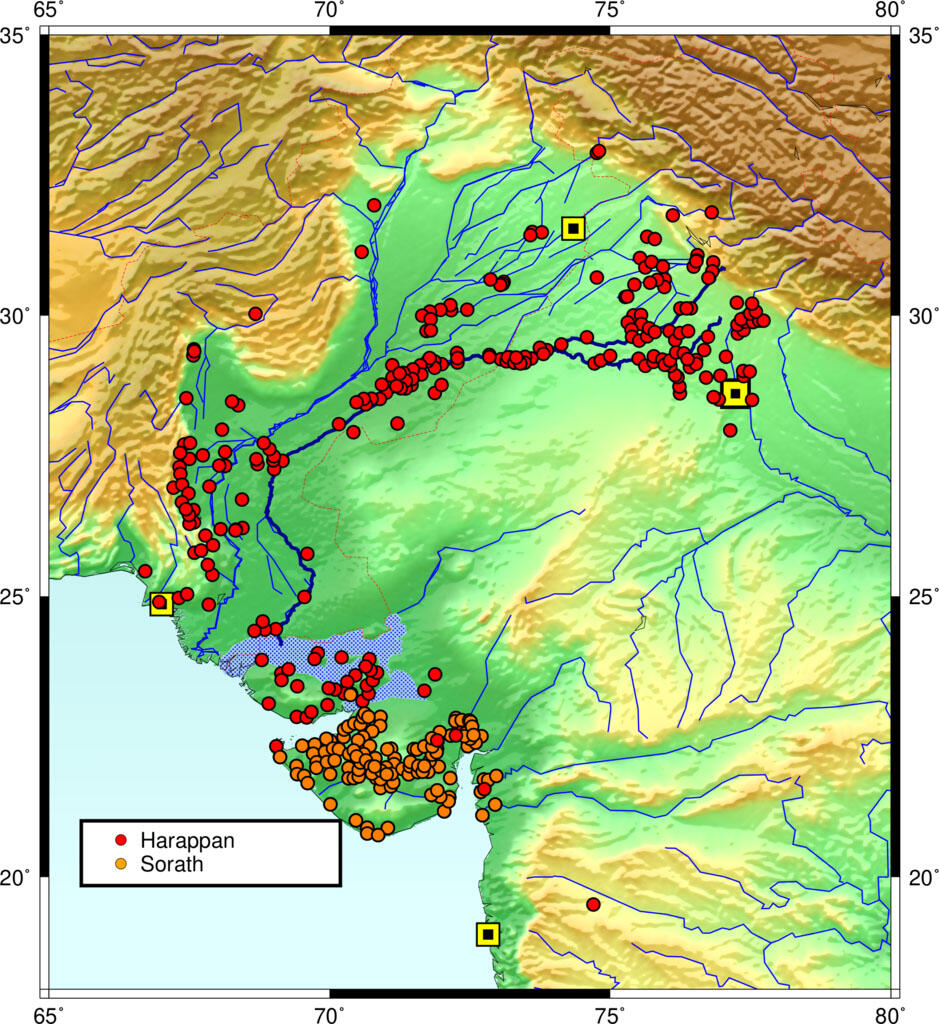An insightful paper that covers a lot of important ground: a brief history of Indus discoveries and excavations in Gujarat, a look at the core vs. periphery model of cultural expansion that has been used to theorize that Indus people from Sindh moved into Gujarat, the evidence on early inhabitants of Gujarat around and just before Indus times, and a definition of "Sorath Harappans." It is here that the author begins to find problems with earlier thinking: "However, the most important question that arises is: If Sorath is a part of the Mature Harappan complex and working for the civilization as a whole, then what was the need of the Sindhi Harappan people to migrate into the area? This interpretation makes the scenario confusing and the issue that is not addressed directly is the relationship between the Sindhi and Sorath Harappans . . . As the growing archaeological evidence from Kachchh became prominent, it showed that a well developed and established Early Harappan phase had flourished here, contemporaneous with its counterparts in Sindh and Baluchistan, which lead to this region being added to the ‘core zone’ of the Harappan civilization. However at the same time, it is also treated as a ‘buffer zone’, which allegedly helped the Harappans to migrate into the hinterland of Gujarat i.e. north Gujarat and Saurashtra" (p. 306).
Similarly, he suggests that discoveries now show that pre-Indus cultures existed in Gujarat just as the Amri culture did in Sindh: "The cultural evidence and associated radiocarbon dates from Gujarat sites (see Table 1) confirm the co‐existence of the Amri culture and the Padri‐Anarta Complex in Kachchh. This co‐existence is not due to contacts with such Early Harappan cultures of Sindh and Baluchistan but because Padri‐Anarta is the early regional Chalcolithic culture of northern Gujarat and Saurashtra, and it enters Kachchh in turn, is comparable with Amri II" (p. 307). He finds that "the Padri‐ Anarta Cultural Complex contributed to the development of the Sorath Harappan and thus, it should be recognized as the Early Harappan culture of Gujarat, which reflects a different ecological and economical Early Harappan zone" (p. 308).
Similarly, he takes on the fortifications issue, which may not have been to protect Indus traders who had moved in from hunter-gatherers, but each other. "Therefore, the function of these so called fortifications was probability multipurpose, providing protection from flooding, defining the settlement for administrative or ritual purposes, and possibly defensive when and where necessary (Fairservis 1977; Dales and Kenoyer 1990, Kenoyer 2008)" (p. 310).
The evidence for early settlements in Gujarat, long before Indus times, is also reviewed, as is the continuation of Indus-type settlements following the civilization's apparent decline elsewhere: "The presence of large number of Late Harappan sites in this area has nothing to do with the eastward migrations and colonization of the area by the Mature Harappan life ways and subsequent devolution of Mature Harappan phase, but mainly to do with economy and sustainability of the population" (p. 312). He concludes that we need to rethink our model of how Gujarat's Indus sites fit into the larger Indus context. "We need to approach the Harappan occupation of Gujarat with fresh perspectives and rather than continuing with outdated hypotheses. There is also a need to re‐excavate and/or reanalyze archaeological material from older sites and compare them with new material in the light of new methods, approaches and directions rather than trying to fit such sites and material in old hypotheses" (p. 313).
Image: Mag of Harappan and Sorath Harappan sites. Red circles, mature Harappan sites. Orange circles, mature Sorath Harappan sites. Yellow/Black Rectangles, some modern cities. Source: Wikimedia Commons, by Merikanto

